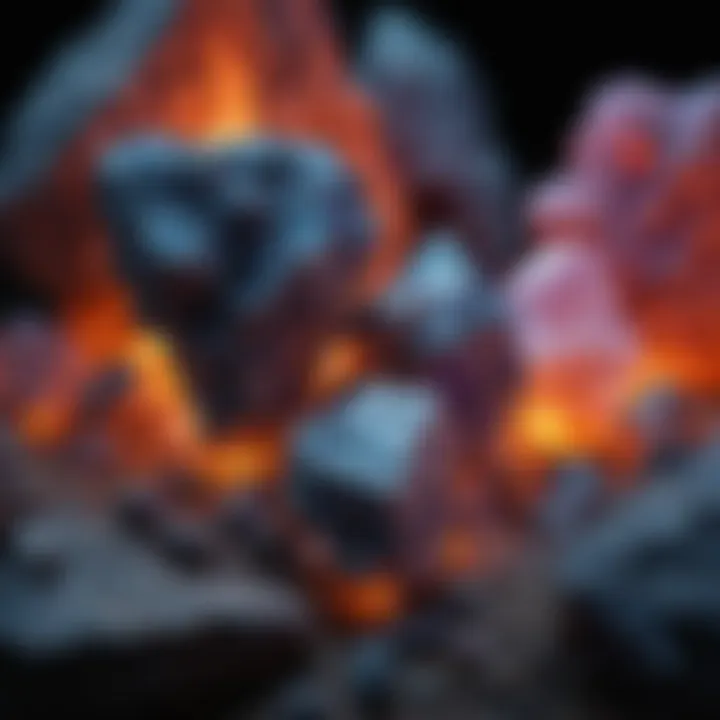The Impact of UV Lamps on Mineral Analysis Techniques


Intro
Ultraviolet (UV) lamps play a significant role in the analysis of minerals. This technology allows for the identification and classification of mineral specimens in ways that conventional methods cannot. The use of UV light reveals properties such as fluorescence, which assists collectors and researchers in making informed decisions about mineral taxonomy. Understanding the principles behind this tool is crucial for anyone engaged in the fields of mineralogy, geology, or even simple collection.
History and Origins
The application of UV light in mineral analysis has a rich history, emerging from the intersection of scientific discovery and practical need. Early geologists first noted the unusual behaviors of certain minerals under UV light in the late 19th century. This sparked interest in their properties and potential uses in mineral identification.
- Overview of Collectibles, Rocks, and Fossils
The world of collectibles encompasses a variety of specimens, including rocks and fossils. Enthusiasts often seek unique pieces that hold both aesthetic and scientific value. The introduction of UV lamps has enhanced the ability to reveal hidden characteristics in these specimens, making previously overlooked pieces desirable. - Historical Significance and Cultural Impact
Many cultures have recognized the aesthetic and spiritual significance of minerals throughout history. The ability to analyze and understand these substances using modern technology not only preserves this cultural significance but also deepens our understanding of Earth’s geological history. Collectors now have the means to appreciate minerals in new ways, attracting attention across the globe.
Identification and Classification
Identifying and classifying minerals has always been a paramount task for collectors and scientists alike. The introduction of UV lamps provides significant advantages in this regard.
- Guide to Identifying Rocks and Fossils
To effectively utilize UV lamps, collectors should be aware of the characteristics to observe when analyzing specimens. Common points of interest include changes in color and intensity of fluorescence, which can indicate the presence of specific minerals. - Common Types and Variations
Certain minerals exhibit distinct fluorescent properties. For example, fluorite, calcite, and scheelite are well-known for their ability to fluoresce brightly under UV light. Understanding these types allows for better identification and encourages further exploration of lesser-known specimens.
"UV light is not merely a tool; it is a gateway to understanding the unseen world of minerals, unlocking secrets that have remained hidden for centuries."
By examining the interplay between UV light and minerals, collectors enhance their methodologies, ultimately enriching their engagement with these tangible pieces of the Earth's history. Through this comprehensive analysis, both novice and experienced collectors can benefit from a deeper understanding of mineral analysis.
Intro to UV Lamps
The role of UV lamps in mineral analysis is pivotal for understanding mineral characteristics and their identification. UV lamps harness ultraviolet light to excite certain minerals, causing them to fluoresce. This property has vast implications in fields ranging from geology to mineral collecting. By mastering the use of UV lamps, mineral collectors can enhance diagnostic precision and streamline their identification processes.
What is Ultraviolet Light?
Ultraviolet light exists just beyond the visible spectrum, having wavelengths shorter than visible light but longer than X-rays. Words like "UVA," "UVB," and "UVC" classify these waves. Each type has unique properties and applications in mineral analysis. UV light can penetrate materials, causing specific reactions or emissions from minerals based on their composition. By understanding these wavelengths, users can optimize their techniques for mineral investigation.
Types of UV Lamps
Fluorescent UV Lamps
Fluorescent UV lamps are a common choice for mineral analysis due to their affordability and availability. These lamps emit UV light through a phosphorescent coating inside the glass. A key characteristic of these lamps is their relatively high intensity, which allows them to reveal a wide range of fluorescent minerals. They are beneficial for enthusiasts and collectors who need to perform preliminary examinations quickly. However, fluorescent lamps can produce a certain amount of heat, which may affect sensitive specimens.
LED UV Lamps
LED UV lamps have gained increase popularity because of their energy efficiency and portability. They produce UV light without generating excess heat, making them ideal for prolonged use. The key characteristic of LED lamps is their ability to emit specific wavelengths, which can be tuned to target specific mineral types. This feature allows for more precise analysis. However, LED UV lamps may not have the same intensity as other types, which can limit their effectiveness in certain situations.
Mercury Vapor Lamps
Mercury vapor lamps are powerful UV light sources, often used for more extensive laboratory setups. They produce intense UV radiation, making them effective for identifying difficult or faintly fluorescing minerals. The unique feature of mercury vapor lamps is their ability to deliver a broad spectrum of wavelengths, thus enhancing mineral detection capabilities. Nevertheless, their size and expense may be a barrier for casual users. Also, safety measures should be in place due to the presence of mercury.
Principles of Fluorescence in Minerals


Fluorescence is crucial when we talk about UV lamps and mineral analysis. Understanding how minerals fluoresce under ultraviolet light can vastly improve identification and understanding of mineral specimens. This section emphasizes the underlying mechanisms of fluorescence and the various factors that can influence the fluorescent properties of minerals. Recognizing these principles can inform collectors, geologists, and enthusiasts in their approach. It is not merely a science; it is an art to pinpoint and appreciate the uniqueness of each mineral specimen.
The Fluorescence Process
The fluorescence process involves the absorption of UV light by minerals, which then re-emit this light at a different wavelength. When a mineral absorbs UV radiation, its electrons become excited. This excitement leads to a temporary state where the electrons can take on higher energy levels. As these excited electrons return to their original states, they release energy in the form of visible light, often producing vibrant hues. The amount of energy released and the color of the emitted light depend primarily on the mineral's specific characteristics.
Factors Affecting Fluorescence
Several elements determine the overall fluorescence of minerals. Among them, chemical composition, crystal structure, and the presence of impurities play significant roles.
Chemical Composition
One essential aspect of chemical composition is the specific elements present in a mineral. Elements such as manganese or uranium are known for their ability to enhance fluorescence. The unique characteristic of particular chemical compositions is their ability to influence both the intensity and color of fluorescent light emitted. For many rock and mineral collectors, this can become a fascinating area of study. The presence of certain trace elements can lead to a different fluorescent response, making chemical composition a key aspect of mineral analysis.
Crystal Structure
Crystal structure also has a defining role in fluorescing properties. The arrangement of atoms and ions within the mineral's lattice affects how it absorbs and emits light. Each unique structure can result in varying degrees of fluorescence, allowing certain minerals to standout under UV light. For instance, minerals with a more ordered lattice structure may exhibit stronger fluorescence compared to their disordered counterparts. This characteristic is vital for collectors looking to identify minerals based on their crystallinity and their related fluorescent behavior.
Impurities
Impurities in minerals are often seen as undesirable but can significantly influence fluorescence. These inclusions can change the way a mineral interacts with UV light, sometimes enhancing its fluorescent properties. It is this unique feature that makes studying impurities beneficial for understanding mineral behavior. Collectors must consider that while impurities can elevate fluorescence, they may also complicate mineral identification due to variations in the expected emission spectrum.
"In mineralogy, knowledge of fluorescence opens paths to deeper understanding and appreciation of specimens' narratives."
In summary, the principles of fluorescence are foundational in mineral analysis. Understanding how the fluorescence process works, as well as the factors affecting it, allows mineralogists and collectors to make informed decisions. Such insights not only improve identification techniques but also enhance the overall experience of studying these remarkable natural formations.
Applications of UV Lamps in Mineral Identification
In the world of mineralogy, the application of UV lamps plays a crucial role in the accurate identification of minerals. UV lamps help geologists and collectors not only to recognize fluorescent minerals but also to analyze specific properties that might be otherwise hidden under normal lighting conditions. By leveraging ultraviolet light, significant insights can be gained about the composition and structure of mineral specimens.
Field Use of UV Lamps
Identifying Fluorescent Minerals
Identifying fluorescent minerals is a key aspect of using UV lamps in the field. Fluorescence is the emission of light by a substance that has absorbed light or other electromagnetic radiation. Certain minerals exhibit this behavior when exposed to UV light. For mineralogical studies, identifying these fluorescent minerals can yield valuable information about their chemical nature. The main characteristic of this identification process is the visual evidence provided; it often reveals unique colors under UV light that are not noticeable in daylight.
The fluorescent properties make it possible to quickly narrow down the potential types of minerals present in a sample. This method is beneficial because it allows collectors to differentiate between similar-looking minerals that may have different compositions. However, relying solely on fluorescence can lead to certain disadvantages, such as the potential misidentification of non-fluorescent minerals that possess similar appearances under regular light. Therefore, while this technique is popular among collectors, it must be used in conjunction with other identification methods for accurate analysis.
Field Testing Techniques
Field testing techniques using UV lamps further enhance the identification process of minerals. These techniques involve the practical applications of UV lamps in outdoor settings, providing a hands-on approach to mineral analysis. Field testing can reveal information about a mineral’s response to UV light in real-time, contributing to immediate identification and analysis.
One of the key advantages of these techniques is their portability. Many UV lamps are lightweight and designed for field use, allowing ease of handling and transport. This makes UV testing an accessible option for collectors who may want to conduct their research away from the laboratory. A unique feature of this technique is its adaptability to various field conditions. However, environmental factors like light pollution or poor weather can affect results, making it essential to choose optimal conditions for field testing. Understanding these testing methods is vital for collectors trying to maximize their identification success in diverse locations.
Laboratory Applications


Sample Preparation
In laboratory settings, sample preparation is an integral part of utilizing UV lamps in mineral analysis. This process involves carefully selecting and preparing mineral specimens for UV examination. Proper sample preparation significantly enhances the accuracy of results, allowing the unique properties of the minerals to shine through under UV illumination.
The noteworthy characteristic of sample preparation is the level of control it offers over how samples are observed. By utilizing precise cutting and polishing techniques, researchers can minimize artifacts that otherwise could lead to misinterpretation of results. This focus on preparation makes it a beneficial choice as it underscores the importance of handling samples correctly. However, an intricate preparation process can be time-consuming, posing a challenge for those seeking quicker identification.
Microscopy and Imaging
Microscopy and imaging using UV lamps represent an advanced application in mineral analysis. This method focuses on the detailed examination of mineral specimens under UV light, providing enhanced visualization of features that are invisible in regular light conditions. The key characteristic of this technique is its ability to offer detailed insights into the structure and properties of minerals at a microscopic level.
Microscopy and imaging are powerful tools that allow for comprehensive analysis. Unlike basic field techniques, this approach can uncover subtle details like fluorescence patterns, defect structures, and inclusions within minerals. However, it requires specialized equipment and training, making it less accessible for casual collectors. Despite this drawback, the advantages in clarity and data can significantly elevate the understanding of mineral specimens, hence being a valuable approach in mineralogy.
The application of UV lamps in both field and laboratory settings not only adds depth to mineral analysis but also fosters a greater understanding of the nature of minerals, enhancing the overall study dynamic a lot.
Benefits of Using UV Lamps
Understanding the benefits of using UV lamps in mineral analysis is paramount for enthusiasts in mineralogy. This technology aids in detecting and characterizing various mineral qualities that may not be visible under normal lighting conditions. As minerals often exhibit unique responses to ultraviolet light, employing these lamps enhances identification accuracy and depth of analysis. This section delves into two main benefits: enhanced detection of mineral properties and cost-effectiveness.
Enhanced Detection of Mineral Properties
UV lamps play a crucial role in the detection of inherent properties of minerals. When minerals are exposed to ultraviolet light, they can fluoresce, meaning they emit visible light after absorbing UV radiation. This feature allows collectors and researchers to distinguish between similar-looking specimens.
Several important points highlight the significance of this property:
- Color Changes: Fluorescence reveals vibrant colors in minerals. For instance, calcite may appear milky white in normal light but may show bright hues under UV light.
- Characteristics Identification: Certain minerals may display specific fluorescence colors which help in easy identification. For example, fluorite can fluoresce a bright green under UV light, assisting in quick recognition of the mineral.
- Inclusion Studies: The examination of inclusions in minerals is more efficient with UV lamps. Fluorescent properties can expose hidden features vital for categorizing specimens.
This enhanced detection dynamic facilitates more robust mineral characterization, benefitting both amateur and professional mineralogists.
Cost-Effectiveness
The use of UV lamps in mineral analysis also brings significant cost-effectiveness. While some sophisticated analytical methods can be expensive and time-consuming, UV lamps present a practical alternative. Here are key reasons for their cost-effectiveness:
- Affordability: Compared to advanced techniques such as X-ray fluorescence (XRF) or electron microscopy, UV lamps are relatively low in cost. This makes them accessible to a wider range of users without compromising on quality.
- Simplified Testing: The straightforward operation of UV lamps allows users to conduct field tests with relative ease. Minimal setup enhances workflow, saving both time and resources.
- Versatility: UV lamps can be employed across various mineral types and applications, eliminating the need for multiple specialized equipment. Thus, collectors can maximize their investment by using one tool for diverse analyses.
"The glow of a fluorescent mineral under UV light can turn the mundane into the extraordinary, revealing secrets hidden in plain sight."
Limitations and Challenges
In the domain of mineral analysis, UV lamps serve as valuable tools, yet they also present limitations and challenges that analysts must navigate. Recognizing these limitations is essential for collectors and researchers aiming to leverage this technology effectively. Understanding the potential pitfalls enhances the accuracy of mineral identification and ensures that the field remains reliable and credible. In particular, potential misidentifications due to reliance on UV light, alongside environmental constraints, encapsulate the primary challenges when using these lamps.
Potential Misidentifications
One of the most critical limitations in using UV lamps occurs in the realm of potential misidentifications. Different minerals may exhibit similar fluorescent properties under UV light, leading to confusion. For example, calcite and dolomite can sometimes appear quite similar, making accurate differentiation difficult without further tests or analyses. Furthermore, fluorescence can be influenced by various factors such as impurities or alterations in the mineral structure, which may not be readily apparent through UV examination alone.
Additionally, it is important to consider the level of expertise of the user. Novices may over-rely on visual observations made under UV lamps without a comprehensive understanding of mineralogy. This over-dependence can lead to misjudgments about mineral identity, affecting the outcome of any analysis. Therefore, it is crucial that those utilizing UV lamps remain cautious and complement their observations with other analytical techniques, such as X-ray diffraction or chemical tests, to corroborate findings.


Environmental Limitations
The effectiveness of UV lamps in mineral analysis is considerably affected by environmental factors. Both light pollution and weather conditions can obscure or alter the results of fluorescence observations, hampering the accurate identification of minerals.
Light Pollution
Light pollution represents a significant impediment to the optimal use of UV technology. It refers to the brightness of artificial light in the environment, which can interfere with the ability to perceive the fluorescence of some minerals. This ambient light can overshadow the often dim glow of fluorescent minerals, making it difficult to observe results clearly. It is crucial for mineralogists and enthusiasts to conduct their work in areas with minimal light pollution to ensure clearer conditions. Choosing to analyze minerals in well-shielded environments will minimize distractions from artificial lighting and enhance the clarity of fluorescence readings.
Weather Conditions
Weather conditions are another notable limitation in utilizing UV lamps for mineral analysis. Factors such as humidity and atmospheric clarity can significantly affect the performance of these lamps. For instance, moisture can absorb or scatter UV light, diminishing its effectiveness and potentially leading to unrepresentative readings. Weather-related effects can vary widely based on geographic location, necessitating careful consideration of the local climate when planning fieldwork. Analysts should opt for clear and dry days for outdoor examinations, as this will ensure the best conditions for accurate mineral observation with UV lamps.
Safety Considerations When Using UV Lamps
When employing UV lamps in mineral analysis, it is imperative to address safety considerations. The nature of ultraviolet light poses distinct health risks that must be acknowledged to ensure the well-being of users. Ignoring these risks can have significant consequences, affecting not only individual safety but also the quality of research and analysis being conducted.
Proper education about UV exposure and its potential effects is crucial. Users must understand that prolonged or unprotected exposure to ultraviolet light can lead to various health issues, emphasizing the need for effective preventive measures.
Health Risks Associated with UV Exposure
Ultraviolet light is categorized into three types: UVA, UVB, and UVC. Even though UVC is mostly absorbed by the ozone layer and doesn’t reach the Earth's surface, the other two types can lead to serious health consequences. Vulnerability to skin disorders is heightened with extensive exposure to UVA and UVB rays. Furthermore, they can cause various eye problems, including photokeratitis and conjunctivitis.
These risks are particularly critical for mineralogists and rock collectors using UV lamps in both indoor and outdoor settings. Regular, unprotected UV exposure can escalate the chances of skin cancer, especially among individuals spending long hours under such lights.
Protective Measures
In light of the potential health risks, adopting protective measures is necessary. It ensures the safety of individuals using UV lamps during mineral analysis. Two primary protective measures stand out: Safety Goggles and Skin Protection.
Safety Goggles
Safety goggles are a fundamental aspect of protection when working with UV lamps. They are designed to shield the eyes from dangerous radiation emitted by these lamps. A crucial characteristic of safety goggles is their capacity to absorb UV light. This feature significantly reduces the risk of eye injuries or disorders caused by exposure. These goggles are a popular choice among collectors and researchers due to their effectiveness in preventing light-induced damage.
The unique feature of safety goggles lies in the lens material. Many are made from polycarbonate, which can block out harmful wavelengths effectively. This advantage is vital in protecting users. However, not all goggles provide the same level of protection; thus, it is essential to choose those specifically rated for UV exposure.
Skin Protection
Skin protection is equally important when using UV lamps. Engaging in prolonged exposure without proper skin coverage may lead to adverse health conditions. A notable characteristic is the use of protective clothing. This includes long-sleeved shirts and pants that cover exposed skin.
This type of protection is essential because it minimizes direct UV contact, lowering the risk of skin burns and other conditions like premature aging or skin cancer. One effective approach is the use of sunscreen with high SPF, which adds another layer of defense. However, it is important to remember that not all sunscreens are equally effective against UV rays, so selecting one that specifically mentions UV protection is crucial.
Finale
The role of UV lamps in mineral analysis cannot be understated. As this article has explored, the usage of ultraviolet light opens up new avenues for enhancing the identification and study of minerals. The effectiveness of UV lamps in revealing specific properties of minerals, such as fluorescence, is crucial for collectors and researchers. This technology not only aids in distinguishing similar specimens but also provides insight into their chemical composition and structural characteristics.
Future Trends in UV Lamp Technology
As we look towards the future, the advancement of UV lamp technology is on the horizon. Innovations such as more energy-efficient LED UV lamps are gradually replacing traditional mercury vapor lamps. These new options not only consume less power but also reduce harmful emissions, making them appealing for both environmental and health reasons. Moreover, the integration of smart technology may allow for adjustable wavelength settings, enabling precise examination of various minerals under tailored light conditions.
Final Thoughts on Mineral Analysis
In summary, the insights provided in this article underline the profound impact that UV lamps have on the field of mineral analysis. For rock and fossil collectors, embracing this technology gives them an edge in identifying and appreciating mineral specimens. The benefits, while considerable, must be balanced with awareness of their limitations and safety measures. Adapting to future advancements in UV lamp technology can further enhance the methods used in mineral identification, ultimately fostering a deeper understanding and appreciation of the natural world.



